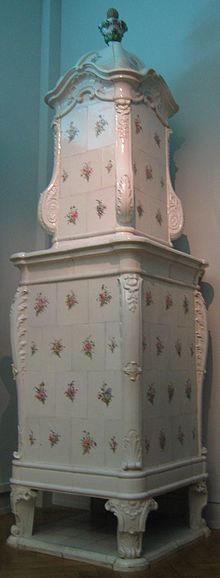Faience Manufactory Frisching

The Faience Manufactory Frisching was a manufactory that produced high-quality faience products in the Lorraine in Bern from 1760 to 1776 .
Foundation, location and products
There were two faience factories in the city of Bern, that of Augustin von Willading (1758 – approx. 1765) and that of the Frisching brothers (1760–1776).
The factories were located outside the old town on Altenberg . Their owners were not stoners themselves , but entrepreneurs. Franz Rudolf Frisching was previously a colonel in the Dutch service, where he may have gained insight into faience production.
The Frisching Manufactory was founded in 1760 by Franz Rudolf Frisching (1733–1807) and his brothers Gabriel Friedrich (1731–1789) and Karl Albrecht (1734–1801) on the land of the country estate of Franz Rudolf, the "Lorraine-Gut", in Lorraine -Quartier founded. The faience factory was located on today's Uferweg 4, in the area of the "Rabbental-Güter", which also belonged to the Frisching brothers and which were partially combined with the "Lorraine-Gut". The whole area below today's Lorraine Bridge belonged to Colonel Franz Rudolf Frisching in the second half of the 18th century. In addition to tableware, the manufactory was primarily known for its polychrome faience tiled stoves with floral motifs. Due to protectionism, the manufacture in the city of Bern could not sell a single stove. The high-quality freshness ovens were all the more popular with the rich silk ribbon manufacturers in Basel . In Basel, it was considered chic to equip your townhouses with faience stoves from the Frisching manufactory. Very elaborately designed specimens of these freshly glazed faience ovens, some of which are multicolored, are in the salon and dining room of the Wildt'schen Haus in Basel.
The master craftsman was responsible for the technical expertise in the factories. The first master apprentice at Frisching was the faience painter Johann Adam Spengler (1726–1790) from Schaffhausen . But in 1762 he moved to Zurich , where he became the first director of the porcelain factory in Kilchberg. His successor was the potter Daniel Herrmann (1736–1798) from Langnau in the Emmental . Under Hermann's direction, the manufactory produced a number of splendid tiled stoves. Today more than forty tiled stoves can still be assigned to the Frisching faience manufacture.
The brand of the Frisching manufactory is a big blue "D" with a dot in front of and after it, so ".D.". The brand could not be interpreted until today.
Locations of tiled stoves from the Frisching manufactory
- The blue and the white house in Basel
- Wildt'sches Haus in Basel
- Hünegg Castle near Hilterfingen
- New Oberdiessbach Castle
- Schadau Castle
- Historical Museum Bern
- Hôtel DuPeyrou in Neuchâtel
literature
- Fernand Schwab / Hans Lehmann: The faience and porcelain factories in the Bern area. In: Anzeiger für Schweizerische Altertumskunde, New Series 23, 1921, 123-131.
- Rudolf F. Burckhardt: Ovens in Basel houses from the Frisching'schen Fayencemanufaktur near Bern. In: Anzeiger für Schweizerische Altertumskunde New Series 30, 1928, 168–180.
- Walter A. Staehelin: Unknown ovens from the Frischingschen faience factory near Bern. In: Ceramic Friends of Switzerland, Bulletin 14, 1949, 12-14.
- Walter A. Staehelin: Ceramic research from Bernese archives. In: Ceramic Friends of Switzerland. Newsletter. No. 81, 1970, ISSN 0023-0553 , pp. 3-34.
- Robert L. Wyss: The stoner Salomon Landolt in Neuenstadt. In: Peter Meyer (Ed.): Illustrated Bern Encyclopedia. Volume 4: Art and Culture in the Canton of Bern. Büchler, Wabern-Bern 1987, ISBN 3-7170-187-6 , pp. 107-109.
- Adriano Boschetti-Maradi: Pottery and Pottery in the Early Modern Age in the Canton of Bern. Writings of the Bernisches Historisches Museum 8, Bern 2006, esp. 191-195
- Adriano Boschetti-Maradi: tableware for town and country. Bernese pottery since the 16th century. Highlights from the Bernisches Historisches Museum 19. With photographs by Yvonne Hurni. Chronos-Verlag, Zurich 2007, ISBN 3-0340-0864-3 .
- Adriano Boschetti-Maradi: The tiled stove - a necessity and a showpiece. In: André Holenstein (Ed.): Bern's golden time. Rediscovered in the 18th century (= Bern times. 4). Stämpfli Verlag AG, Bern 2008, ISBN 978-3-7272-1281-9 , p. 112.
- Jegenstorf Castle (Ed.): In focus - the collection of historical tiled stoves at Jegenstorf Castle. Jegenstorf 2013, esp. 60–67.
Web links
- Monument Preservation Basel-Stadt ( Memento from March 12, 2012 in the Internet Archive )
- Victoria & Albert Museum : Plate, made in the Frisching Brothers Factory, Switzerland, Bern, about 1770, c.35-1942 [2010 (TAB)]
Individual evidence
- ^ A b c Adriano Boschetti-Maradi: Crockery for town and country. 2007, p. 22.
- ^ Adolf Hebeisen: The Lorraine in Bern. Origin, becoming and their present being (= Berner Zeitschrift für Geschichte und Heimatkunde. Supplement. 4, ZDB -ID 555604-1 ). Paul Haupt, Bern 1952, Appendix p. 28.
- ↑ Peter Landolf: The Faience Manufactory Frisching on Altenberg. In: Leist-Post. No. 1, 2010, pp. 2-3 .
- ↑ Biography: Andreas Heege / Andreas Kistler, ceramics from Langnau. On the history of the most important land havings in the canton of Bern (Writings of the Bernisches Historisches Museum 13), Bern 2017, 109–114.
- ^ Walter A. Staehelin, Ceramic research in Bernese archives: The furnaces of the Frisching Manufactory, in: Keramik-Freunde der Schweiz, Mitteilungsblatt 81, 1970, 3-35.
